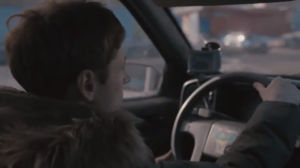Andrew Chapman, Dartmouth College
Oksana Bychkova’s film, Another Year (Eshche odin god [2014]), uses the genre of the drama and a mismatched and doomed relationship to analyze a rift between classes: newly formed digital yuppies of the 2000s and 2010s are incompatible with their analog Soviet and 90s era worker.
Zhenia works as a web designer for an unnamed .com company. She is a representative of Moscow’s growing computer industry, but more importantly, the newly emerging .com worker is viewed as a digital version of the creative class, the intelligentsia of the Soviet era and the 1990s. Her husband, Komar, makes money illegally through fares in his personal car, working day and night driving the suited higher classes across Moscow. He is educated, but lacks the will or skills to find meaningful employment, and is thus relegated to the margins of the service industry. Komar is an orphan of the old regime, a lumpen proletariat who has failed to make the transition. His dislocation is shown spatially in his daily journeys across Moscow, where he is eventually beaten by a businessman after he cannot make change for a 5000 ruble note.
In seemingly another world, the film pays close attention to the .com office space and its modern trappings, which ditches the individualized claustrophobic cubicle cell in favor of the open collaborative workspace. It is no coincidence that the company’s holiday party takes place in this space, and also serves as the site of the conflict between the film’s two main characters.
Bychkova’s film is extremely nuanced in its exploration of class differences. In one scene, the fighting couple argues at a supermarket, disagreeing on what to bring to a different holiday party. She chooses a bottle of Coca-Cola, recognizing the appropriateness of brand names as offerings, and it is only at the checkout counter that we see the bottle has been replaced by a generic brand soda. The detail is not inserted as a commentary of how one class spends their earned money. The soda is an item deeply rooted in class-consciousness and even Soviet era consumer history, and is an embarrassing item to bring to the party.
As the relationship collapses, each partner pursues other romantic connections. One great linguistic nuance in the film is how the two romantic partners each label Komar’s profession. When his wife Zhenia tells him to get a real job, she says he should not “bombit’,” a slang word that denotes the dangers of operating a personal cab. As Komar begins his romantic involvement with another woman, who is clearly of the same social background as him, she instead introduces him to her family as a taxi driver (taksist).
Another Year does not resolve class differences, and while each partner of the broken up couple still has yearnings for one another, the film does end in their reunion. Rather, their class incompatibilities play out through the drama and the tragic fate of one member. For as much as the working class is depicted as a remnant of the past in the film, it is the one that survives in the end. The film certainly recognizes the continuing remnants of the Soviet working class; both the good and bad engrained behaviors of the Soviet citizen are alive and well in today’s Russia. They even reproduce. The creative class is rendered sickly and not reproductive. Their ineffectiveness lies in their inability to assert any real power outside of shallow social status and cultural capital.
December 2014


